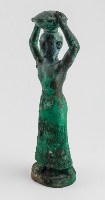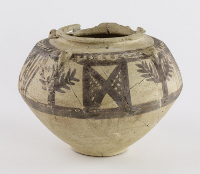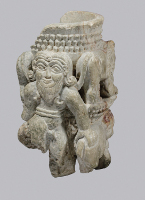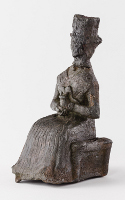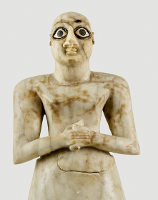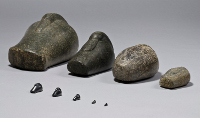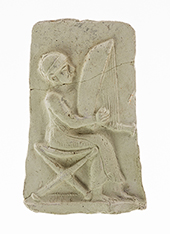Mesopotamia - the land between the rivers, the Tigris and the Euphrates - is an ancient Greek term used by archaeologists to refer to the area now roughly equivalent to the modern country of Iraq. The Mesopotamian collection of the Oriental Institute Museum was acquired almost exclusively through archaeological excavations. The first of these - the University of Chicago Oriental Exploration Fund's expedition to Bismaya (ancient Adab) - worked in Iraq from 1903-1905. During the 1930's the Babylonian Section of the Iraq Expedition excavated four sites on the lower Diyala River, and today the Nippur Expedition is continuing its work, begun in 1948, at the holy city of Nippur. The material that has been brought back as a result of divisions of finds from these expeditions forms one of the major world collections, covering in depth the civilizations of ancient Mesopotamia.
Foundation Figurine of King Ur-Nammu
King Ur-Nammu rebuilt and enlarged one of the most important temples in ancient Mesopotamia - the E-kur of Enlil, the chief god of the pantheon. This figurine, which was buried in a foundation box beneath one of the temple towers, represents the king at the start of the building project - carrying on his head a basket of clay from which would be made the critically important first brick. The foundation deposit also contained an inscribed stone tablet; beads of frit, stone and gold; chips of various stones; and four ancient date pits found perched atop the basket carried by the king.
Striding Lion
This colorful striding lion, its mouth opened in a threatening roar, once decorated a side of the 'Processional Way' in ancient Babylon (the Biblical city of Babel). The 'Processional Way' led out of the city through a massive gate named for the Mesopotamian goddess of love and war, Ishtar, whose symbol was the lion. Each year, during the celebration of the great New Year Festival, the images of the city's deities were carried out through the Ishtar Gate and along the 'Processional Way' past some 120 lions such as this one to a special festival house north of the city.
Four-Lugged Vessel
Short, squat jars with painted decoration on the shoulder and four pierced lugs are characteristic of the period around 3000 B.C. in Mesopotamia. Many are decorated with only geometric designs; on this vessel a tree was added beneath each lug. Probably strings were passed through the lugs and used to tie a lid securely in place over the jar's low neck, thus safeguarding its contents.
Female Figurine
Figurines like this one have been found in the excavated remains of Mesopotamian houses, temples, and other public buildings of the early second millennium B.C. They have no definite divine attributes and their exact function is not known. This female has characteristic broad, flat hips, a large and elaborately incised pubic triangle, and prominent breasts with applied disk-shaped nipples. The multiple holes pierced at the sides of her head may have held metal earrings or served to fasten the piece to a separate material, such as cloth.
Cup Supported by Hero and Animals
This elaborate vessel was discovered in the Shara Temple where it was probably used to place offerings before the god. The decoration of its openwork support shows a hero, naked except for a double-strand belt, grasping the rumps of two lions in his hands. The curling tails of two additional lions are tucked under his arms, and all four felines menace a bearded bull at the opposite end of the stand. Series of figures such as these, engaged in static combats, are common in ancient Mesopotamian art. Their exact meaning is unknown.
Four-Faced God and Goddess
Illicit diggers found these four-faced statuettes, which may represent a god of the four winds and a goddess of rainstorms. The god wears a low cap with a pair of horns meeting above each face. He carries a scimitar in his right hand and places his left foot upon the back of a crouching ram. The goddess's tall crown, again with a pair of horns above each face, has the shape of a temple facade or altar. She grasps in her hands a vase from which flow streams of water; a rippled water pattern covers her garment.
Sumerian Statuette
During the Early Dynastic Period in Mesopotamia, statuettes were placed in sanctuaries as votive offerings and were later buried when the temple was remodelled or rebuilt. This representation of a Sumerian standing reverently before his god is one of a group of sculptures found buried in a pit next to the altar of the Abu Temple at Tell Asmar. It is thought to depict a priest because it lacks the full beard and long hair of other male statues of its type.
Banquet Plaque
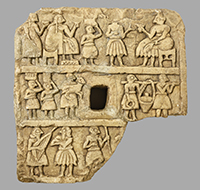 The top register of this plaque shows a seated man and woman celebrating an unidentified event or ritual by participating in a banquet. Two servants attend them while others bring a jar (probably filled with beer), an animal to be slaughtered, and other edibles carried in bundles on their heads. Musicians and dancers in the bottom register add to the festivities.
The top register of this plaque shows a seated man and woman celebrating an unidentified event or ritual by participating in a banquet. Two servants attend them while others bring a jar (probably filled with beer), an animal to be slaughtered, and other edibles carried in bundles on their heads. Musicians and dancers in the bottom register add to the festivities.
Plaques such as this were part of a door-locking system for important buildings. The plaque was embedded in the doorjamb and a peg, inserted into the central perforation, was used to hold a hook or cord that secured the door and was covered with clay impressed by one or more seals.
Clay Tablet and Envelope
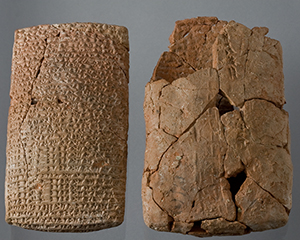 Enclosed in its clay envelope, this tablet was stored in a private archive of more than 1,000 texts. The tablet records the outcome of a litigation between two men, both of whom claimed to own the same estate. The judges ruled in favor of the individual who provided written statements attesting to his ownership of the land from residents of nine neighboring towns. Two court officials rolled their cylinder seals across the front of the tablet after it was inscribed, guaranteeing that the information it contained was correct.
Enclosed in its clay envelope, this tablet was stored in a private archive of more than 1,000 texts. The tablet records the outcome of a litigation between two men, both of whom claimed to own the same estate. The judges ruled in favor of the individual who provided written statements attesting to his ownership of the land from residents of nine neighboring towns. Two court officials rolled their cylinder seals across the front of the tablet after it was inscribed, guaranteeing that the information it contained was correct.
Gazelle-Head Stamp Seal/Amulet
In central and southern Mesopotamia, both stamp and cylinder seals appeared together near the end of the third millennium B.C. Many stamp seals were carved in the form of an animal or an animal head, and the sealing surface was decorated with simple designs - often representing animals - comprised of drill-holes and incised lines. It is possible that many of the stamps were not actually used as seals but were worn primarily as amulets.
Cylinder Seal
 This cylinder seal was dedicated to a little-known goddess, Ninishkun, who is shown interceding on the owner's behalf with the great goddess Ishtar. Ishtar places her right foot upon a roaring lion, which she restrains with a leash. The scimitar in her left hand and the weapons sprouting from her winged shoulders indicate her war-like nature.
This cylinder seal was dedicated to a little-known goddess, Ninishkun, who is shown interceding on the owner's behalf with the great goddess Ishtar. Ishtar places her right foot upon a roaring lion, which she restrains with a leash. The scimitar in her left hand and the weapons sprouting from her winged shoulders indicate her war-like nature.
Pazuzu Demon
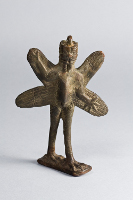 The demon Pazuzu represented by this figurine stands like a human but has a scorpion's body, feathered wings and legs, talons, and a lion-like face on both front and back. Pazuzu, the "king of the evil wind demons," was not entirely unfriendly to mankind. As an enemy of the dreaded Lamashtu demon, bearer of sickness especially to women and children, Pazuzu is often portrayed on amulets used as protection in childbirth. The ring at the top of this figurine suggests that it was such an amulet.
The demon Pazuzu represented by this figurine stands like a human but has a scorpion's body, feathered wings and legs, talons, and a lion-like face on both front and back. Pazuzu, the "king of the evil wind demons," was not entirely unfriendly to mankind. As an enemy of the dreaded Lamashtu demon, bearer of sickness especially to women and children, Pazuzu is often portrayed on amulets used as protection in childbirth. The ring at the top of this figurine suggests that it was such an amulet.
Duck Weights
The Mesopotamians used sets of standard weights in conducting business and set stiff penalities for those who used false weights. The weights themselves were usually made of a very hard stone like hematite. A simple barrel shape was the most common form, but weights such as these in the form of a duck, with its neck and head resting along its back, were also prevalent.
Plaque Showing a Harpist
Harps are known from the earliest period of written history, but the fringed robe and close-fitting cap of this harpist are typical for the early second millennium B.C. in Mesopotamia. Clay plaques from this period depict musicians playing a variety of stringed, percussion, and wind instruments. The casting of plaques was a simple and inexpensive way to produce relief images, since numerous plaques could be made from a single mold.

